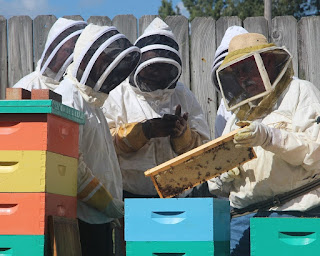The environmentally conscious group meets between services at
their Conway, Arkansas, church. The recently formed group’s enthusiastic members
are committed to making a positive impact on the neighborhoods where they live.
They invite guest speakers of varying backgrounds to discuss matters in which
the members can have an impact. I was honored to be invited to share with the
group some ideas for protecting pollinators and providing habitat. One of their
first efforts will be to establish pollinator gardens. The enthusiasm, efforts,
and examples of the group’s members will surely spread to their neighbors and
lead to networks of pollinator gardens, pollinator pastures, and pollinator
corridors.
As a beekeeper, I was also privileged to speak to the group
with the approach of Christmas. I explained that there was a well-established
tradition of Bronze Age, Mid-East beekeeping in the fourteenth century B.C.;
and bees and honey were mentioned in the writings of many of the great religions:
the Hebrew and Christian Bible, the Talmud, and the Quran. Honey bees were
managed throughout the Mid-East, Africa, and Europe. I related the way that the
church in Europe supported bees for centuries. Following the fall of the
Western Roman Empire in 476 A.D., libraries were burned, and education was
discouraged. Few people outside the monasteries could read and write. European
abbeys and monasteries had apiaries, and their monks managed bees for honey,
mead, and beeswax for candles and lost wax molding of religious items. The
religious orders were the repository of knowledge of worldly matters and
beekeeping for a thousand years. When Europeans voyaged to the Americas in the
early 1600s, they viewed the New World in biblical terms as a “land of milk and
honey.” However, since the Americas lacked the necessary cattle or honey bees,
the Pilgrims brought them with them. Today’s photo: Ethiopian Orthodox church,
Addis Ababa, Ethiopia. The Underhill family of Peace Bee Farm offers to the
people of the great religions, philosophies, and naturalistic traditions that peace
be with you.
--Richard












